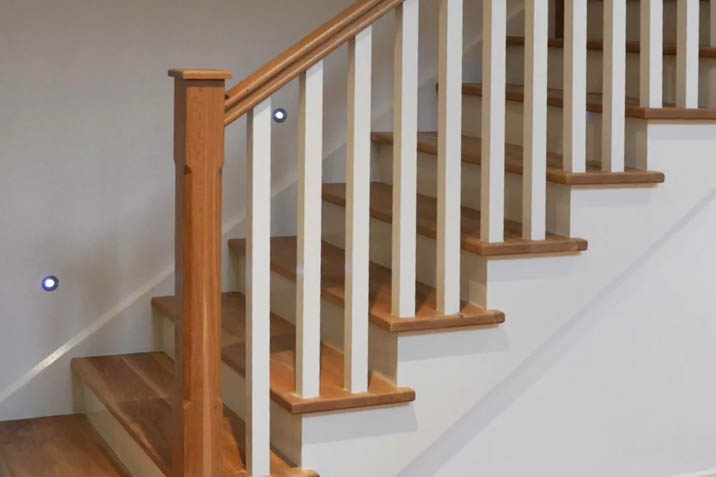

New ideas and designs for wooden stairs
Why are wooden stairs so popular?
Why are wooden stairs so popular?
The primary reason that most people choose timber for their staircases is aesthetics, particularly indoors. Wooden staircases add warmth into a room, bringing a breath of rustic air into your décor. Wood stairs are versatile and can come in many different colours/finishes, so a sleek contemporary look is also easy to obtain.
Another benefit to timber stairs is their general material properties. Wood steps are pleasant underfoot, easy to clean, and can last up to 35 years outdoors. They are desirable and will add value to your house in the event that you decide to sell. Wood stairs are also environmentally friendly (provided that you source sustainable timber).
Timber stairs are very popular in Australia. The two most common types of timber used for stairs are pine (for its affordability) and oak (for its durability). However, the majority of Australian hardwoods would also be perfect for stairs. This includes Eucalyptus, Tasmanian Oak, Blackbutt, Spotted Gum and Jarrah.
There are a few factors which make a good timber staircase. If you are contemplating building timber stairs, these are the things you want to pay attention to.
1. How thick are the planks?
The thicker the planks of the stairs, the longer it will last. However, go too thick and the material might be too heavy to use. You need to find a middle ground that works for the size and height of the staircase, the likely traffic around your home, and the available timber types.
2. Type of timber and manufacturers concerns
Make sure that you are using an appropriate timber for the staircase. Softwoods will rarely be durable enough to make a long lasting staircase. Each type of wood will have a different price range, so keep your budget in mind during selection. You should also be aware that some woods may take longer to find than others – for example, Victorian Ash may not always be readily available. Plan your renovation accordingly.
3. Dimensions and guidelines
A good staircase must follow the Australian guidelines for stairs. This dictates step width and dimensions to maximize safety. Consult them here.
With an understanding of some fundamental considerations, you can now start searching for inspiration. To help you ensure that your wooden stairs design is unique, fit to your household and will bring you joy for the years to come, here are some of the best timber stair ideas in modern homes.
Design ideas for timber stairs
10. Nosing

The horizontal edge of the stair is known as the nosing. This is where the majority of foot traffic will occur and therefore it will see the most wear. To fortify wooden stairs against this, some homeowners are choosing to lay laminate flooring over the top of the stair. This provides a protective layer that will keep the wooden stair underneath looking pristine for many years to come.
9. Landing platform

A landing platform is a large flat area in a flight of stairs, usually towards the middle or just at the start. Landing platforms provide a place to rest during the climb and also make it possible for you to place stairs along corners. They also ensure that the incline of the stairs is not too steep. You can have multiple landing platforms on the one flight of stairs, like the picture above.
8. Treads, details and rods

The details of your staircase can have a drastic effect on the overall aesthetic and functionality. Cultivating your staircase design to suit the background of your home is a great way to present a sense of unified décor – for example, the optical illusion pictured above.
7. Wood wall mounted stair handrail

A railing or handrail is a good idea to ensure the safety of your stairs. This is especially true if you have younger children or elderly people in your family who may be at risk of damaging falls. Mounting a handrail to the wall will help your family members to find their balance with ease and walk your stairs without fear.
6. Baluster

A baluster is another type of railing which will keep your family safe. Balusters are more sturdy than mounted handrails, because they have more bulk and can actually block you from falling (rather than just guiding you down).
5. Modern timber

Engineered timber is a modern material taking the world of design by storm. It is cheaper, more durable, and more waterproof than regular timber. Read about more examples of engineered timber here.
4. All wood

Allwood Stairs is an Australian stair manufacturer based in Gosford, NSW. They are known for their extensive range of balusters and stair enhancements, but they can also design and install custom stairs for their clients. Read more about AllWood stairs here.
3. Outdoor

You may have heard the phrase ‘staircase in the woods’ at one point in your life. This phrase is a reference to the mysterious staircases sometimes found in forests which seemingly lead to nothing. Now, you don’t have to install a staircase to nowhere on your property – but having an outdoor timber staircase will certainly capture some of this whimsical mysticism.
2. Dark wood stair gate

Who says baby-proofing has to be all plastic? This gorgeous hardwood gate will work just fine as a protective barrier to stairs. Whether you’re protecting a child or some less-than-agile pets, you can purchase it here or attempt to DIY.
1. Indoor

Without a doubt, the best place for a wooden staircase is indoors. Wood will last much longer when sheltered from the elements, and the bright colours of timber bring a natural warmth into any room.



